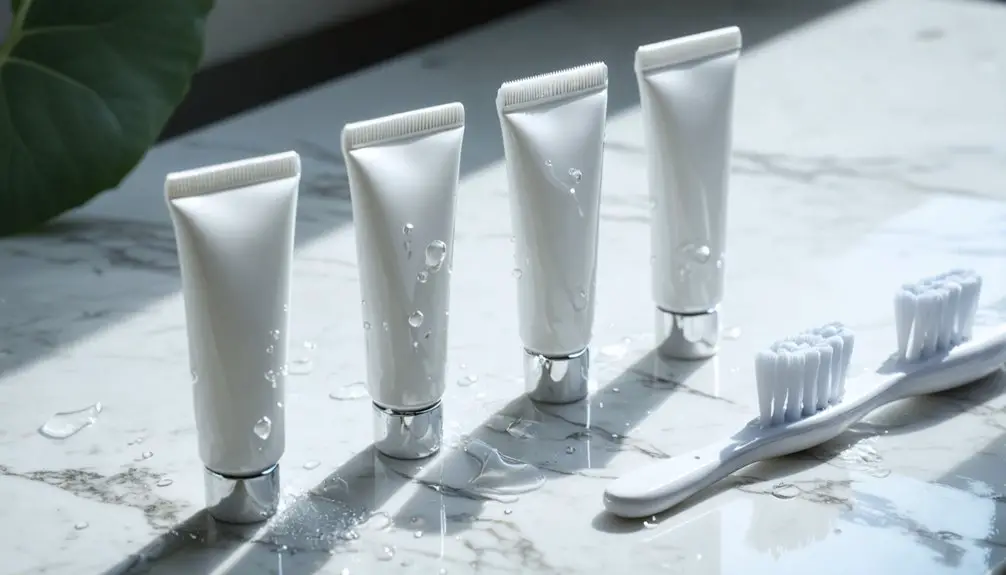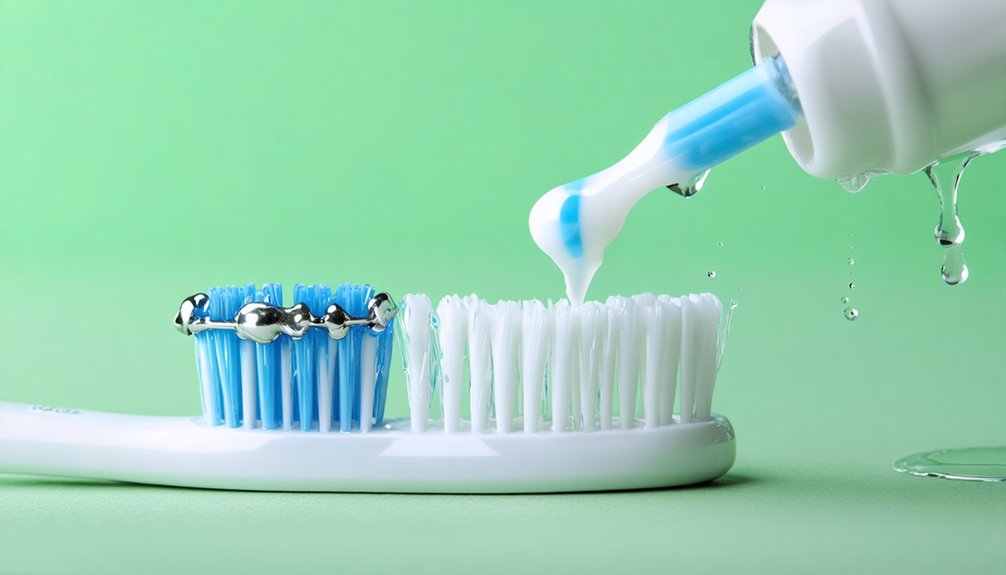You’ll find specialized smokers’ toothpaste contains powerful stain-fighters like hydroxyapatite and silica that effectively combat nicotine and tar discoloration. These formulations also include gum-protecting ingredients such as zinc compounds and xylitol to address smoking-related oral health concerns. For best results, combine your toothpaste with proper brushing technique, daily tongue cleaning, and regular professional cleanings. Understanding the key ingredients and proper oral care techniques can help maximize your smile-brightening results.
Key Takeaways
- Choose toothpaste with stain-fighting ingredients like hydroxyapatite and silica specifically formulated to combat nicotine and tar stains.
- Look for formulations containing blue covarine, which provides optical brightening while removing surface stains from tobacco use.
- Select toothpaste with mild abrasives like calcium carbonate that safely polish away stains without damaging tooth enamel.
- Use whitening toothpaste containing hydrogen peroxide to penetrate enamel and lighten deeper tobacco stains beneath the surface.
- Pair smokers’ toothpaste with a sonic toothbrush for enhanced stain removal and better cleaning effectiveness.
Understanding How Smoking Affects Your Teeth
While many smokers focus primarily on the health risks to their lungs and heart, smoking’s devastating effects on oral health can lead to severe, lasting damage.
When you smoke, you’re exposing your mouth to harmful toxins that impair your immune system and reduce blood flow to oral tissues. These smoking effects include increased risk of periodontal disease, leading to gum recession, bone loss, and potential tooth loss.
Your saliva’s protective properties become compromised as smoking alters its composition, making it thicker and more acidic. This change creates an environment where harmful bacteria thrive, accelerating tooth decay and gum disease. Studies show that eight out of ten oral cancer patients are tobacco users.
Smoking’s impact on saliva creates a hostile oral environment, transforming your mouth into a breeding ground for decay-causing bacteria.
Additionally, tobacco deposits leave stubborn stains on your teeth that regular oral hygiene can’t easily remove. Understanding these impacts is essential for developing an effective dental care strategy to protect your oral health.
Key Features to Look for in Smokers’ Toothpaste
When choosing a toothpaste designed for smokers, you’ll want to focus on formulations containing proven stain-fighters like hydroxyapatite and silica that specifically target nicotine and tar discoloration.
Your toothpaste should include gum-protecting ingredients such as zinc compounds and xylitol to combat the increased risk of periodontal disease associated with smoking. Top Smile Smokers Care delivers effective gum care through its specialized formula.
You’ll also benefit from enhanced whitening agents like blue covarine that provide both immediate optical brightening and long-term stain removal to counteract tobacco-related tooth discoloration. Look for toothpaste with tartar control ingredients that help prevent hard buildup on teeth.
Stain-Fighting Active Ingredients
Effective stain-fighting toothpaste for smokers relies on four core types of active ingredients working synergistically.
You’ll find carefully calibrated abrasive agents like hydrated silica and calcium carbonate that provide ideal abrasive effectiveness without damaging enamel. For optimal results, use the toothpaste twice a day after meals. These work alongside fluoride compounds that strengthen teeth while supporting stain removal. The cool mint flavor provides a lasting fresh sensation while fighting stains.
- PVM/MA copolymers and specialized binding agents trap and lift stubborn nicotine stains
- Natural extracts like propolis and thyme oil deliver antibacterial and anti-inflammatory benefits
- Fluoride benefits include enhanced enamel protection during the stain removal process
When selecting your toothpaste, look for products containing a balanced combination of these ingredients.
The right formulation will effectively combat tobacco stains while maintaining oral health through controlled RDA levels and therapeutic concentrations of active compounds.
Gum Protection Properties
Smokers require specialized gum protection properties in their toothpaste due to tobacco’s devastating effects on periodontal health.
Look for formulations containing bisabolol and allantoin, which actively reduce inflammation and soothe irritated gum tissue. These ingredients work alongside panthenol to promote healing and strengthen your gum barrier.
Your toothpaste should include antibacterial agents like zinc chloride and probiotics to combat harmful bacteria that cause gum infections. The recommended concentration of sodium monofluorophosphate content ensures optimal protection against bacteria buildup.
Fluoride content, particularly sodium fluoride or monofluorophosphate at 1000 ppm, helps protect both enamel and gums while reducing gingival bleeding.
For ideal gum health, choose products with hydrating components like sorbitol and xanthan gum, which form a protective barrier against irritants.
Natural ingredients such as xylitol and erythritol support a healthy oral environment while inhibiting bacterial growth. Nano-hydroxyapatite in advanced formulas provides deep enamel remineralization for comprehensive oral protection.
Extra Whitening Power
Beyond gum protection, the battle against tobacco-related tooth discoloration demands specialized whitening agents in smokers’ toothpaste. You’ll find multiple whitening techniques working together to combat stubborn stains while maintaining enamel safety. The combination of mild abrasives like calcium carbonate and silica with peroxide compounds creates a powerful dual-action approach. Using a sonic toothbrush significantly enhances the effectiveness of whitening toothpaste for smokers. Regular cleanings are essential to remove built-up plaque and tartar before whitening treatments can be most effective.
- Gentle abrasives physically polish away surface stains while being safe for daily use
- Hydrogen peroxide and carbamide peroxide penetrate deeper to break down embedded nicotine and tar stains
- Remineralizing ingredients like hydroxyapatite strengthen enamel during the whitening process
For ideal results, look for formulations that balance these whitening agents with protective elements. The synergistic effect of combined ingredients guarantees you’re getting thorough stain removal without compromising your tooth structure.
Top Ingredients That Combat Tobacco Stains
A range of specialized ingredients works together to combat stubborn tobacco stains on teeth.
You’ll find mild abrasives like calcium carbonate and silica that gently scrub away surface discoloration while maintaining enamel protection.
For deeper stains, oxidizing agents such as hydrogen peroxide and carbamide peroxide penetrate the enamel to break down and lighten tobacco stains from within.
Your teeth’s defense is strengthened by fluoride compounds that remineralize weakened enamel and help prevent future staining.
Antibacterial ingredients like zinc compounds and triclosan control plaque buildup while fighting bad breath associated with smoking. Regular use can help reduce the persistent bad breath that often plagues smokers.
Natural fresheners, including peppermint oil and xylitol, provide additional breath-freshening benefits while supporting your overall oral health during the whitening process.
Daily Oral Care Routine for Smokers

Building upon effective ingredients, your daily oral care routine requires specific attention to combat smoking’s effects on oral health. As a smoker, you’ll need to be more vigilant about maintaining peak oral hygiene to counteract harmful chemicals and prevent common dental issues.
Implement these essential steps to protect your oral health:
- Brush twice daily with smoker-specific toothpaste, and rinse immediately after smoking habits to minimize chemical exposure.
- Clean your tongue daily with a scraper and floss between teeth to remove tar buildup and bacteria.
- Stay hydrated throughout the day and use alcohol-free mouthwash to maintain healthy saliva flow.
Remember to replace your toothbrush regularly and schedule frequent dental check-ups for professional cleaning and early detection of potential issues.
Your consistent attention to these details will help preserve your dental health despite smoking.
The Role of Xylitol in Protecting Smokers’ Teeth
While tobacco use poses significant risks to oral health, xylitol emerges as a powerful protective agent for smokers’ dental care. This natural sweetener disrupts harmful bacteria like Streptococcus mutans, which are typically elevated in smokers’ mouths, while creating an environment that promotes tooth remineralization.
You’ll find several xylitol benefits that directly counter smoking’s negative effects. It stimulates saliva production, neutralizes acids, and forms a protective barrier against tobacco-related damage.
When you use products containing 10% xylitol, such as toothpaste or mouthwash, you’re actively fighting plaque buildup and promoting dental hygiene. For ideal protection, consider chewing xylitol gum every three hours – it’s a practical substitute that can help reduce smoking urges while simultaneously protecting your teeth from decay.
Professional Dental Care Tips for Tobacco Users

You’ll need to schedule dental check-ups every three months as a tobacco user to combat your heightened risk of gum disease and tooth decay.
During these visits, your dental hygienist can remove stubborn tobacco stains and plaque buildup that contribute to periodontal problems.
To protect your gums between visits, maintain meticulous daily brushing and flossing routines, while following your dentist’s specific recommendations for antiseptic rinses and specialized cleaning tools.
Regular Dental Check-Ups
Although tobacco users face heightened risks of oral health problems, studies show they’re less likely to maintain regular dental check-ups compared to non-smokers. The importance of routine check-ups can’t be overstated, as tobacco users have 2.6 times greater risk of tooth loss and twice the likelihood of reporting poor oral health.
Overcoming dental barriers is crucial for your oral health. Consider these strategies to maintain consistent care:
- Ask your dentist about payment plans or sliding scale fees if cost is a concern
- Schedule appointments every six months to catch problems early and reduce long-term expenses
- Request smoking cessation support during visits, as dental professionals can provide effective counseling and resources
Regular check-ups help prevent serious complications and guarantee successful treatments, particularly if you’re considering dental implants or other restorative procedures.
Plaque Removal Strategies
Since tobacco use accelerates plaque formation and tartar buildup, smokers require specialized cleaning techniques both at home and during professional dental visits.
Your plaque control techniques should include gentle, circular brushing motions aimed at the gumline using fluoride toothpaste at least twice daily. Don’t forget to clean your tongue and all tooth surfaces thoroughly.
For effective tartar management strategies, you’ll need professional deep cleaning procedures every 3-4 months. These sessions include scaling and root planing to remove hardened deposits above and below the gumline.
You can support these efforts by rinsing with water after smoking and chewing sugar-free gum to stimulate saliva production. Remember to replace your soft-bristled toothbrush regularly to maintain peak cleaning effectiveness and prevent gum injury.
Gum Disease Prevention
Professional dental care plays an essential role in preventing gum disease among tobacco users, who face twice the risk of periodontal problems compared to nonsmokers.
To protect your oral health while using tobacco products, you’ll need a thorough approach that combines regular dental visits with proper home care techniques.
Key preventive measures include:
- Schedule dental checkups every 3-4 months for professional cleaning and early detection of periodontal issues
- Use prescription antimicrobial mouth rinses to combat harmful bacteria and reduce inflammation
- Consider smoking cessation programs, as quitting tobacco is the most effective way to reduce gum disease risk
Your dentist can monitor periodontal pocket depth and attachment loss, which tend to be more severe in smokers (3.8mm vs. 2.5mm in nonsmokers).
Early intervention greatly improves treatment outcomes and helps prevent disease progression.
Frequently Asked Questions
Can Smokers Use Whitening Strips Alongside Specialized Toothpaste for Better Results?
You can use both products together for improved whitening effectiveness. Combined treatments target stains at different depths, but you’ll need to follow proper timing and avoid products with overlapping peroxide content.
How Long After Quitting Smoking Will Tooth Stains Naturally Begin to Fade?
You’ll notice natural fading of tooth stains about six months after you quit smoking, though some discoloration may remain permanent. Professional cleaning can help accelerate and enhance the natural fading process.
Are Electronic Cigarette Users at Risk for the Same Dental Problems?
Yes, you’ll face similar dental risks with vaping effects including periodontal disease, tooth decay, staining, and oral lesions. Regular dental hygiene and professional cleanings are essential to minimize these potential complications.
Does Charcoal Toothpaste Work Differently for Tobacco Stains Versus Regular Stains?
Yes, charcoal’s effectiveness differs with tobacco stains – it combines abrasive scrubbing with adsorptive properties to lift stubborn tar and nicotine deposits, while regular stains mainly require surface-level mechanical removal.
Should Smokers Brush Immediately After Smoking or Wait Some Time First?
You shouldn’t brush immediately after smoking. Wait 30-60 minutes to protect your enamel, as smoking creates an acidic environment. Meanwhile, rinse with water to minimize smoking effects on your teeth.
References
- https://pmc.ncbi.nlm.nih.gov/articles/PMC3444372/
- https://pmc.ncbi.nlm.nih.gov/articles/PMC3263647/
- https://dergipark.org.tr/tr/download/article-file/782309
- https://www.nationaldentalpbrn.org/blog/study-spotlight-effectiveness-of-nicotine-replacement-sampling-in-dental-practices/
- https://www.todaysrdh.com/case-study-xylitols-role-in-the-4ds-of-smoking-cessation/
- https://pmc.ncbi.nlm.nih.gov/articles/PMC9423024/
- https://www.betterhealth.vic.gov.au/health/healthyliving/smoking-and-oral-health
- https://www.cdc.gov/tobacco/campaign/tips/diseases/periodontal-gum-disease.html
- https://pmc.ncbi.nlm.nih.gov/articles/PMC9875717/
- https://mypenndentist.org/dental-tips/2019/10/03/what-does-smoking-do-to-your-teeth/



